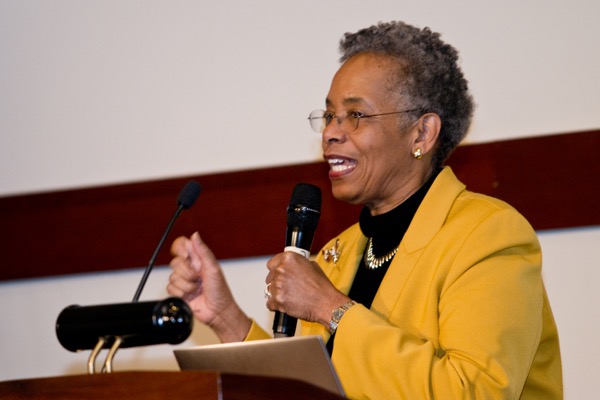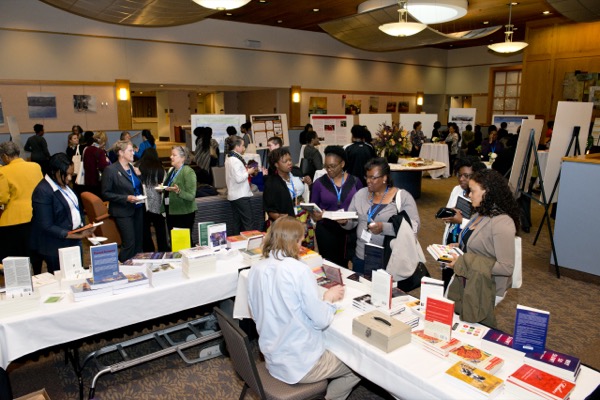Toward greater diversity and excellence
Research illuminates what's needed to 'color the academy'
Editor's note: For full coverage also see "A call to 'Color the Academy'" and "Stories behind the Statistics."
6:17 p.m., May 6, 2016--“Color the academy.” That hashtag for the ADVANCE national research conference at the University of Delaware boldly stated what most U.S. universities need to do, and many like UD are working on, to achieve greater diversity, and with it, excellence.
Although growing the ranks of women faculty of color is still an uphill climb, researchers are gradually exposing the rocky places and the slippery spots that higher education must tend to for minority professors to not just survive their academic journey — but thrive.
Campus Stories
From graduates, faculty
Doctoral hooding
During the three-day conference at UD, April 29–May 1, more than 175 attendees from 20 states and 50 institutions came together to discuss the latest research, compare experiences, and share strategies for success.
Stacie Furst-Holloway, a researcher at the University of Cincinnati, spoke about how her urban university with more than 40,000 undergraduates is working to do a better job of retaining women faculty from underrepresented minorities. Only 4 percent of that university’s faculty are black and 2 percent are Latino, numbers that have not shifted in the past 20 years.
So far, her team’s research has shown that women of color hired as assistant professors are more likely to leave the university than men hired at the same level. By seven years after their hire, half of these women have left the university versus 20 percent of the men.
To understand what’s driving that trend, she and her colleagues are examining faculty productivity using one traditional academic measure — the number of journal articles published.
So far, their research on six STEM departments, in which 135 faculty are being tracked, shows that at the time of hire, the men have published twice as many journal articles as the women.
While quantity is not necessarily a better measure than quality of research publications, there is a need to understand why such differences exist, Furst-Holloway said. It could indicate a systemic issue — women may be disadvantaged in graduate school or even earlier, with limited access to state-of-the-art research tools or to experienced researchers as mentors. Further research hopes to reveal the story behind the numbers.
University of Cincinnati exit data show that women faculty of color leave that institution because they are burned out and feel like they don’t fit in.
Quality of life outside the university often gets overlooked. “Where can you go to worship? Where can you go to get your hair done?” One professor said she tries to help answer such questions for new hires.
“Your network, being embedded in a community, is hugely important,” Furst-Holloway said.
Her university intends to develop a career action plan for every new faculty member to show what the expectations are for getting tenure. New approaches to establishing departmental research collaborations also will be explored since women have fewer of them than men, and building stronger professional networks in the greater community also will be an aim.
A national initiative
Although the number of women professors is on the rise, the number of full professors from underrepresented minorities unfortunately is not.
“We're not going to succeed if we got half the team on the bench, especially when it’s the smarter half of the team,” said Joan Ferrini-Mundy, assistant director for education and human resources at the National Science Foundation, quoting President Obama at the White House Science Fair in April.
She said that NSF is committed to “keep progress happening.”
“We view broadening participation as a solution, not a problem to be solved,” Ferrini-Mundy said.
Earlier this year, the federal agency launched NSF INCLUDES (Inclusion across the Nation of Communities of Learners of Underrepresented Discoverers in Engineering and Science). The initiative, led by NSF director France Cordova, is designed to develop STEM talent from all sectors and groups by building models, networks and partnerships that scale up what works locally to reach underserved populations nationwide.
In a Feb. 22 letter announcing the initiative, Cordova said, “Diversity — of thought, perspective, and experience — is essential to achieving excellence in 21st century science and engineering research and education.” She also cited a business case for diversity. A McKinsey and Company study found that companies were 15 percent more likely to gain financial returns above the national industry median if they were in the top quartile of gender diversity; the probability climbed to 35 percent for companies in the top quartile for racial/ethnic diversity.
Ferrini-Mundy said that better data, including from her own agency, and case studies on women faculty of color are needed, as well as descriptive accounts from institutions where these faculty are achieving success. She also urged universities to synthesize and share their research through popular articles on implicit bias and intersectionality, as well as on diversity’s value.
Personal narratives shed light on policies, practices
Apriel K. Hodari, a physicist and principal investigator at Eureka Scientific Inc., shared selected narratives compiled from research interviews of nearly 600 high-achieving women of color. They not only give insight to the difficulties these women face, but also point to policies and practices for positive change.
Jessica, a black postdoc at a private research institution, struggled with the lack of relatable role models in academia. Her adviser chose to carry out routine data collection versus attend the birth of his child. Jessica, for whom family is a huge priority, could not understand this behavior. Her work also required relocation internationally to do her research, and she constantly faced the pressure of having to make a choice for her family or being a role model at the forefront of science.
Yvette, a black engineering professor at a large public university, was always being questioned about her work ethic by her department chair. It got so bad she felt she had to put a Post It note on her door even when she went to the bathroom. Ultimately, she hid her pregnancy from her department chair because he was making assumptions about her work ethic.
Based on the experiences of these women, Hodari summed up some of the policies and practices departments need to take:
- People with privilege need to take advantage of family friendly policies because that makes it okay for others to do so.
- Enforce zero tolerance for discrimination.
- The culture of the workplace is heavily influenced by the leadership.
- Women of color face the issue of belonging.
- Ask people what they need.
Don’t just survive — thrive
Robbin Chapman, associate provost and academic director of diversity and inclusion at Wellesley College, spoke about the difference between surviving and thriving in academia.
As a graduate student, she developed a framework to make sure she was leveraging all of her “cultural capital” and positioning it as a resource. Noted on the Excel spread sheet of her Thrive Mosaic are hundreds of special people — family, friends, colleagues, students, collaborators — “whoever reminds you of what’s true about yourself,” she said.
“Being a scholar isn’t this one thing,” Chapman explained. “It’s more holistic. I want to be my whole self, bring it to my workplace and be valued for it.”
Chapman said you need people who can mentor you. She “didn’t know what she didn’t know” going into her academic career, and she got a lot of advice over the years from a community that she built “very, very wide.”
To cultivate mentors and connectors, find opportunities for brief conversations to build the relationship. Ask if they will help recommend you for a certain committee or board. She suggests checking in with mentors at least twice a year, following them on social media and planning regular touchpoints such as notes in Christmas cards.
“Make sure some people in your network have influence and can advocate for you — that can speak for you and know your work,” she said.
About the Women of Color in the Academy conference
Focusing on faculty women of color, especially in STEM fields, this research conference provided opportunities for participants to discuss and learn about cutting-edge research on the recruitment, retention, advancement and leadership of faculty women of color, while highlighting their lived experiences. Over 175 faculty, administrators, students, and government and industry representatives from more than 50 institutions in 20 states attended the conference.
The UD ADVANCE Institute plans to post the keynote addresses on its website, and the documentary, Living Thinkers, is available in the University of Delaware Library for viewing.
Support for the conference came from the UD ADVANCE Institute, the Office of the President, the Office of the Provost, the Vice Provost for Diversity, and the Department of Philosophy’s Class of 1955 Fund.
About UD ADVANCE
The ADVANCE Institute is a National Science Foundation ADVANCE-IT funded program that focuses on institutional transformation and is designed to enhance the representation and advancement of women faculty in STEM fields and women faculty of color in all fields. The program will ensure an inclusive campus culture by bringing awareness at all levels—from the upper administration to the faculty—of the impact of unconscious bias in recruitment, hiring and advancement practices. It will thereby create a more equitable path forward for all faculty and lead to a climate that ensures success for women faculty of all fields.
Article by Tracey Bryant
Photos by Lane McLaughlin













